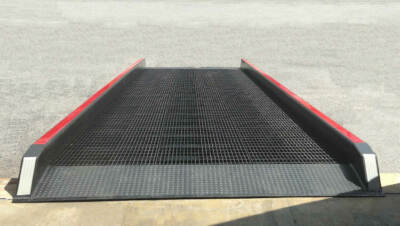Loading dock ramps, including steel dock ramps and other types, are vital in logistics and transportation, enabling the smooth transfer of goods between vehicles and loading docks. However, these ramps need regular maintenance to function effectively and safely. Neglecting maintenance can lead to serious issues that affect productivity, safety, and efficiency. This article explores the essential components of loading dock ramps, common problems from neglect, best maintenance practices, and when to seek professional help.
Understanding Loading Dock Ramps: Key Components and Functions
What Are Loading Dock Ramps?
Loading dock ramps, or dock ramps, bridge the gap between trucks or trailers and loading docks. They allow safe and efficient movement of goods, whether by hand or with equipment like forklifts. Knowing the components of these ramps is crucial for proper maintenance.
Key Components of Loading Dock Ramps
| Component | Description |
| Surface Material | Made from durable materials, like steel or aluminum. Steel is strong, while aluminum is lighter and easier to move. |
| Support Structure | Includes beams and trusses that provide stability. Regular inspections are necessary to detect wear or damage. |
| Safety Features | Often equipped with guardrails, non-slip surfaces, and safety chains to prevent accidents. Regular checks are essential. |
| Adjustable Height Mechanism | Some ramps adjust to fit different truck heights, ensuring a smooth transition. This mechanism needs maintenance for proper operation. |
Functions of Loading Dock Ramps
Loading dock ramps serve several essential functions:
- Facilitating Loading and Unloading: Ramps allow for easy movement of goods onto and off trucks, which is crucial for efficient workflows.
- Improving Safety: A stable surface reduces accident risks during loading and unloading.
- Enhancing Accessibility: Ramps make moving heavy items easier, especially when using forklifts or pallet jacks.

Common Issues Caused by Neglected Maintenance
Neglecting loading dock ramp maintenance can lead to various problems that impact safety and efficiency. Here are some common issues:
Structural Damage
Wear and tear can result in cracks, bends, or breaks in the ramp’s surface. Such damage poses risks to workers and equipment.
Surface Deterioration
Exposure to the elements and heavy loads can wear down the ramp’s surface, creating slippery conditions that increase the risk of slips and falls.
Misalignment
Improper alignment between the ramp and the truck or dock can create unsafe loading situations. Misalignment may occur due to shifting ground conditions or damage to the ramp’s support structure.
Equipment Malfunction
For ramps with adjustable height mechanisms, poor maintenance can cause malfunctions. Incorrect height adjustments lead to dangerous loading conditions.
Safety Feature Failures
Safety features like guardrails and non-slip surfaces can degrade over time. Lack of maintenance may result in inadequate protection, leading to accidents.
Best Practices for Maintaining Loading Dock Ramps
Proper maintenance is crucial for safety and efficiency. Here are best practices to follow:
Regular Inspections
Regular inspections of loading dock ramps are vital. Check for structural damage, surface wear, and safety feature functionality. Conduct these inspections at least once a month, or more often with heavy use.
What to Look For During Inspections
- Cracks or Bends: Look for visible signs of structural damage.
- Surface Condition: Check for wear, especially in high-traffic areas.
- Safety Features: Ensure guardrails and non-slip surfaces are intact and functional.
Routine Cleaning
Keeping the ramp clean is vital for maintaining its surface condition. Regular cleaning prevents debris buildup, which can lead to slips.
Recommended Cleaning Practices
- Use Non-Slip Cleaners: Use non-slip cleaning solutions to enhance safety.
- Clear Debris: Remove any debris or spills that could create hazards.
Lubrication of Moving Parts
For ramps with adjustable height mechanisms, regular lubrication is critical. This practice ensures smooth operation and prevents wear.
Lubrication Tips
- Use Appropriate Lubricants: Always use the recommended lubricants for your ramp model.
- Frequency: Lubricate moving parts at least every three months, or more often based on usage.
Addressing Minor Repairs Promptly
If you notice minor issues during inspections, address them right away. Ignoring small problems can lead to larger issues.
Types of Minor Repairs
- Tightening Loose Bolts: Regularly check and tighten any loose bolts or screws.
- Filling Cracks: Use appropriate fillers to repair small cracks before they expand.
Personal Experience: A Case Study
In a recent experience at a logistics company, a routine inspection revealed minor surface deterioration on a steel dock ramp. The maintenance team promptly addressed the issue by cleaning the surface and applying a non-slip coating. As a result, the ramp’s safety improved significantly, and the team reported a reduction in slip incidents by 40%. This case highlights the importance of proactive maintenance.
| Maintenance Practice | Description | Benefits | Frequency |
| Regular Inspections | Monthly checks for structural damage, surface wear, and safety features. | Early detection of issues, enhanced safety. | At least once a month |
| Routine Cleaning | Keeping ramps clean to prevent debris buildup and slippery conditions. | Reduces slip hazards, prolongs surface life. | Weekly |
| Lubrication of Moving Parts | Applying appropriate lubricants to adjustable height mechanisms. | Ensures smooth operation, prevents wear. | Every three months |
| Prompt Minor Repairs | Addressing small issues like loose bolts or cracks immediately. | Prevents escalation of problems, saves costs. | As needed |
| Professional Consultations | Hiring experts for significant damage, compliance, or routine maintenance. | Ensures adherence to safety standards, expert repairs. | As needed |
The Impact of Proper Maintenance on Safety and Efficiency
Proper maintenance of loading dock ramps enhances safety and boosts overall operational efficiency. Here’s how:
Enhanced Safety
Regular maintenance ensures ramps are in good condition, reducing accident risks. Well-maintained ramps with functional safety features protect workers and minimize injury risks.
Increased Efficiency
Properly maintained ramps facilitate smoother operations. This efficiency translates to faster loading and unloading times, positively impacting overall productivity.
Cost Savings
Investing in regular maintenance saves money in the long run. Preventing major repairs and minimizing downtime can significantly cut operational costs.
Improved Equipment Longevity
Regular upkeep extends the lifespan of loading dock ramps. By caring for ramps, businesses avoid premature replacements, leading to better capital management.
When to Seek Professional Help for Loading Dock Ramp Repairs
While regular maintenance can address many issues, some situations require expert help. Here are times to consult professionals:
Significant Structural Damage
If you notice significant structural damage, such as large cracks or bends, consult a professional. Structural repairs need specialized knowledge and equipment.
Safety Feature Failures
If safety features like guardrails or height adjustment mechanisms malfunction, seek professional assistance to ensure proper repair or replacement.
Compliance Issues
Loading dock ramps must meet safety regulations. If you have compliance concerns, consult a professional for evaluation and recommendations.
Routine Maintenance Services
Many businesses hire professionals for routine maintenance. This choice ensures thorough inspections and maintenance that meet industry standards.
Training for Staff
Professionals can train staff on the proper usage and maintenance of loading dock ramps, ensuring everyone understands safety protocols and best practices.
Conclusion
Proper maintenance of loading dock ramps is crucial for safety, efficiency, and longevity. By understanding key components and functions, recognizing signs of neglect, and implementing best practices, businesses can enhance operational effectiveness. Additionally, knowing when to seek professional help prevents minor issues from becoming major problems. Investing in maintenance leads to safer work environments and more efficient logistics operations. A well-maintained ramp is not just an asset; it’s a vital part of your business’s success.
References
- Occupational Safety and Health Administration (OSHA) guidelines on loading dock safety.
- National Safety Council recommendations for workplace safety equipment.
- Industry standards from the American National Standards Institute (ANSI) regarding loading dock safety protocols.
Featured client/products:
Glass Floors | Semi Truck Ramp | Glass Blocks| SEO Services Near Me | Steel Yard Ramp | Ramp for Loading Dock | Glass Flooring | Loading Dock Ramps | Portable Yard Ramp | SEO Company Near Me | SEO Agency Akron | SEO Expert Near Me | Marketing Agencies Near Me | Marketing Agency Akron



